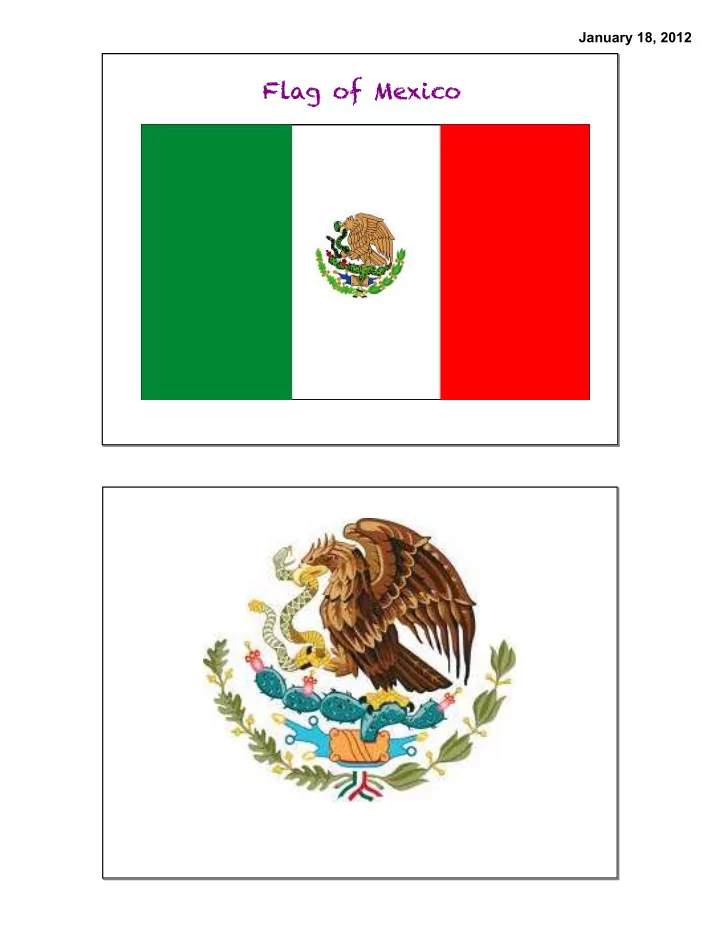

January 18, 2012 Flag of Mexico
January 18, 2012 Geography note: The Aztec did NOT live in a rain forest. They lived in a valley and basin surrounded by the Sierra Madre Mountains.
January 18, 2012 Timeline Home at Last The Aztecs lived on a small island in Lake Texoco and began to acquire through trade the materials needed to enlarge their civilization. They dredged the lake bottom and heaped the soil onto floating gardens called chinampas. Tenochtitlan, the Aztec's central city, was built on an enlarged island and connected to the mainland by causeways. They developed a canal system for transportation of goods.
January 18, 2012 Lake Texcoco was a fresh water lake in the Valley of Mexico. It has evaporated completely and the Mexican capital of Mexico City now lies where the lake once did. Description of the City In the center was a great double pyramid dedicated to Huitzilopochti and Tlacloc (gods of sun and rain). Nearby was a giant rack where thousands of human skulls were displayed. Surrounding this area were the homes of the nobles. These were two story structures that had as many as 50 rooms. Tenochtitlan had many gardens and trees and even a zoo with swans, ducks, cages of snakes, eagles and jaguars. The three causeways that connected the city to the mainland were 25-30 feet wide and had drawbridges cut at intervals. The city was very clean with good drainage. Human waste and garbage was hauled away on barges. A crew of a thousand men swept and washed down public streets every day. Cleanliness was considered essential and people bathed every day.
January 18, 2012 Tenochtitlan This was the center of the Aztec empire. It covered about 5 square miles and was densely populated. By 1502 the city was home to between 80,000 - 250,000 people. Only China had larger cities at the time. About 60,000 people would go to the market daily. Mural of the Aztec market at Tenochtitlan by Diego Riviera
January 18, 2012
January 18, 2012 The Start of an Empire Between 1345 and 1440 the civilization began a career of conquest that put them in control of a vast empire within 100 years. They became a dominant power in the Valley of Mexico. Their large population required more resources than the lake could provide, so they extended their empire in a confederation of subjected city-states. Each city-state they conquered would pay tribute to Tenochtitlan, but could otherwise govern itself. Huitzilopochtili had to be honored as the supreme god. Tribute was payment in the form of cacao beans, cotton, feathers, precious stones, jaguar skins, eagles, shells, dyes, cloth, gold, silver, sandals, corn or other resources. The End of an Empire Tenochtitlan is currently buried under Mexico City. It was completely demolished by the Spaniards after their conquest. Native and Spanish descriptions give us a fairly detailed account of what the city once looked like and archeologists have uncovered many buildings since the 1978 discovery of ruins underneath Mexico City. We will discuss this further after the video.
January 18, 2012 Aztec Achievements Science & Technology The city of Tenochtitlan was an engineering achievement with its causeways and artificial islands or chinampas . Aztecs adopted the Maya solar calendar. Language and Writing The Aztecs enjoyed giving flowery speeches. They had a writing system that used glyphs and pictographs. They did not have a written expression for all words. Priests mostly used writing to list data or keep a record of events. Aztec Achievements . . . continued Arts Poetry was written to praise the gods. Music and dance were important parts of religious ceremonies. Painters used brilliant colors to depict the gods and religious ceremonies. Sculpture was done on buildings and to create small figurines. Architecture The Aztecs were known for their massive stone temples
Recommend
More recommend